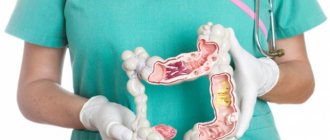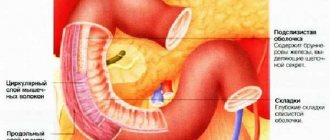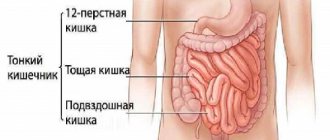In this serious condition, the patency of the small or large intestine , which prevents the passage of food and liquid through it.
Intestinal blockage (obstruction) can be caused by many conditions, including hernias, intestinal adhesions, and tumors. Intestinal obstruction can present with a wide range of unpleasant symptoms, including abdominal pain, constipation, nausea and vomiting. If the obstruction is not treated, it can cause part of the intestine to die, intestinal perforation, severe infection in the abdomen (peritonitis), shock, and death. However, with timely and correct treatment, bowel obstruction can be successfully treated without long-term health consequences.
Types and causes of intestinal obstruction
According to the nature of the course, acute intestinal obstruction is distinguished from chronic; intestinal obstruction can also be complete or partial.
By origin it can be congenital or acquired. Congenital intestinal obstruction in children is caused by abnormalities in the development of the intestine or blockage of it by dense meconium - feces formed during the intrauterine development of the fetus.
Depending on the cause that caused it, intestinal obstruction is divided into two types: dynamic and mechanical.
Dynamic intestinal obstruction is caused by disorders of innervation and blood circulation in the intestines.
In turn, it is divided into the following forms:
- Paralytic intestinal obstruction. It occurs as a result of paralysis of the muscular layer of the intestine, which stops peristalsis - the movements that move chyme through the intestines. It is a complication of peritonitis (inflammation of the peritoneum). Paresis (partial paralysis) of the intestine occurs with renal and biliary colic, acute attacks of pancreatitis, injuries of the pelvis, spine and abdominal hematomas, and can also be postoperative;
- Spastic intestinal obstruction. The cause of spastic intestinal obstruction is intestinal spasm as a result of poisoning with certain medications and salts of heavy metals.
Mechanical intestinal obstruction is the most common type of intestinal obstruction. Divided into the following subspecies:
- Obstructive intestinal obstruction. Occurs in the presence of a neoplasm that partially or completely blocks the intestinal lumen (fecal stones, tumors, cysts, helminth balls), it is characterized by a gradual increase in symptoms;
- Strangulating intestinal obstruction. Associated with compression or strangulation of the intestinal mesentery (volvulus, intestinal nodes), this type is characterized by rapid development, 4-6 hours from the moment of onset until complete obstruction;
- Mixed or combined intestinal obstruction. Occurs during intussusception, when the intestinal lumen is clogged by an invading intestine, and the mesentery of the invading loop is compressed. Intussusception is the most common cause of intestinal obstruction in children.
Intestinal obstruction is also classified by level:
- Small intestinal obstruction;
- Large intestinal obstruction;
- High intestinal obstruction;
- Low intestinal obstruction.
Complications
The consequences of small intestinal obstruction may be as follows:
- coprostasis – stagnation of feces in the lumen of the large intestine;
- constipation – difficulty defecating (passing feces out);
- intoxication syndrome - poisoning of body structures by toxic products formed due to stagnation of feces in the intestines;
- attachment of an infectious agent;
- multiple organ failure – deterioration in the functioning of a number of organs and tissues that occurs against the background of intoxication syndrome;
- perforation of a loop of the small intestine - the formation of a hole in its wall through which contents exit into the abdominal cavity.
When an infectious agent is attached, primary and secondary infectious complications arise, primarily such as:
- enteritis - inflammation of the mucous membrane of the small intestine;
- colitis – inflammatory lesion of the colon mucosa;
- lymphadenitis - an inflammatory process in regional lymph nodes;
- mesadenitis - inflammatory damage to the lymph nodes of the intestinal mesentery;
- lymphangitis – inflammation of regional lymphatic vessels;
- sepsis - extensive contamination of the entire body with an infectious agent due to its movement with the blood and/or lymph flow, which is accompanied by the appearance of inflammatory or purulent foci in various organs and tissues;
- meningitis - inflammatory damage to the membranes of the brain;
- encephalitis is an inflammatory process in brain tissue.
Symptoms of intestinal obstruction
Each type of intestinal obstruction has different symptoms, but there are signs that are common to all cases:
- The appearance of sharp pain in the abdomen;
- The appearance of vomiting;
- Stopping the passage of gases and stool retention.
These three symptoms of intestinal obstruction have features specific to this condition, so it’s worth talking about them in a little more detail.
- Pain. It has a cramp-like character, painful contractions coincide with the rhythm of peristalsis. At the initial stage, in the interval between pain, the patient may not be bothered by anything at all, or there may be a weak aching dull pain. During an attack, the pain becomes so intense that patients rush around, trying to find a position in which it would decrease. At the peak of pain, the patient can neither scream nor speak, and one of the characteristic symptoms of intestinal obstruction is a quiet groan (“ileus groan”). At this time, cold sweat appears, the pulse quickens - signs of painful shock appear.
- Vomit. In the case of small intestinal obstruction, it is repeated, debilitating, abundant, does not bring relief, first containing the remains of undigested food, then consisting of intestinal juices mixed with bile. In the next period, when peritonitis occurs, painful vomiting occurs with stagnant contents of the lower parts of the intestine, which has the appearance and smell of feces - “fecal vomiting”. With large intestinal obstruction, vomiting may occur no more than once or twice; fecal vomiting is not observed.
- The symptom of stool retention and passing gas also varies depending on the form of the disease. With low or large intestinal obstruction, stool and gas may be completely absent for several days before the onset of acute intestinal obstruction. But with high or small intestinal obstruction, at the initial stage there may be independent stool, or stool caused by an enema. In this case, the absence of stool and gas formation may already be late symptoms of intestinal obstruction.
Other symptoms of intestinal obstruction include: thirst, bloated abdomen, increased peristalsis at the beginning of the disease, and its complete cessation as the condition worsens. At the beginning of the disease, due to strong peristalsis, loud intestinal noises are heard, then peristalsis stops, and complete silence sets in - a symptom of “deathly silence”.
During acute intestinal obstruction there are three stages:
- The initial, or period of “ileus moaning,” lasts from 2 to 12 hours. Characterized by pain, bloating, increased peristalsis;
- Intermediate, from 12 to 36 hours. The pain stops altogether, or loses its attack-like nature and intensity, which is why this stage is called the stage of imaginary well-being. Dehydration and intoxication increase. Peristalsis stops;
- Terminal, or late. Occurs 36 hours after the first signs of acute intestinal obstruction appear. At this stage, the patient’s condition becomes significantly more serious, and all life-supporting systems of the body fail.
Forecast
The prognosis for small bowel obstruction varies. With timely detection of pathology and its adequate management, it is favorable. The prognosis worsens when complications occur and is also difficult in older people.
Kovtonyuk Oksana Vladimirovna, medical observer, surgeon, consultant doctor
just today
( 61 votes, average: 4.36 out of 5)
Deep pyoderma: symptoms and treatment
Calluses on feet: treatment at home
Related Posts
Treatment of intestinal obstruction
Treatment of intestinal obstruction begins with emergency measures to replenish lost fluid and relieve pain shock. The upper sections of the gastrointestinal tract are freed from residual contents using a probe, the lower sections - using siphon enemas. To stop increased peristalsis, antispasmodics are administered at the initial stage to relax the muscle wall. Sometimes, for the treatment of dynamic intestinal obstruction, these measures are sufficient to restore normal intestinal function.
If therapeutic methods for treating intestinal obstruction in its dynamic form are ineffective, and in all cases of mechanical intestinal obstruction, surgical intervention is resorted to, which consists of eliminating the cause of the disease; in the case of necrosis of an intestinal area, its excision and restoration of intestinal patency.
Video from YouTube on the topic of the article:
Total information
Small intestinal obstruction is often detected in surgery - in every seventh patient who was admitted to a surgical clinic with pathology of the small or large intestine.
This disease can be detected in any age category - from children to the elderly.
note
As for childhood, the younger the patient, the higher the likelihood that small intestinal obstruction occurred due to congenital disorders.
Males suffer, as with other types of intestinal obstruction, somewhat more often than females: for every two women diagnosed with small intestinal obstruction, there are three or four men with the same pathology.
Postoperative period
The first days or weeks of the postoperative patient are in the hospital and receive all the appointments of the attending physician:
- diet therapy;
- intestinal stimulation;
- anti-inflammatory therapy;
- intravenous infusions to replenish fluids, minerals, and remove toxins;
- physical therapy to prevent the formation of adhesions (an exception is an abdominal tumor);
- therapeutic exercises.
After discharge from the department, the patient is observed on an outpatient basis and follows all the doctor’s recommendations and prescriptions. It is necessary to perform special physical exercises, but with limited load.
Advice: some operated patients try to spend more time in bed, believing that it is safer (the wound hurts less, the stitches will not come apart, and so on). This is a misconception, the consequence of which can again be obstruction due to the development of adhesions against the background of physical inactivity.
And finally, diet, adherence to which is very important. Nutrition after intestinal surgery depends on its nature and volume, and should be within the scope of the doctor’s individual recommendations. However, there are general nutritional rules that must be followed. This is the exclusion of spicy and rough foods, foods that cause fermentation and bloating (milk, legumes, carbonated drinks), extractive foods, rich broths. The amount of fats and carbohydrates is limited, and the intake of protein and vitamins should be sufficient.
Fermented milk products containing lactobacilli and bifidobacteria to restore intestinal microflora, fruit purees and juices, boiled mucous porridges and soups are recommended. You can expand your diet no earlier than 2-3 months, and only after consulting with a specialist.
The state of health after surgery for intestinal obstruction largely depends on the patient himself. You can avoid repeated surgery and prevent undesirable consequences by carefully following all the necessary medical recommendations.
We advise you to read: how long do they live after surgery for intestinal cancer?
How to treat?
The course of treatment for intestinal obstruction, which leads to constipation and bloating, is complex. That is, the problem can rarely be solved only by changing the diet or taking certain pills.
Typically, intestinal obstruction is treated using three techniques in parallel:
- Drug treatment using certain antispasmodics, including the following: Papaverine. This drug helps to relax and relieve spasms in the intestines by blocking phosphodiesterase, which produces excessive amounts of calcium in the smooth muscle cells of the intestinal tissue (which leads to fecal obstruction). Due to its mild action, it is allowed for use by children and pregnant women;
- Drotaverine (analogs - No-Shpa, Spazmol). The principle of action is similar to Papaverine, but more effective. The other side of the “coin” is that it is contraindicated for young children and women during pregnancy;
- Dicetel (Pinaverium Bromide). This drug is a selective calcium channel blocker. By lowering the level of calcium in the cells of the intestinal muscle tissue, it helps to relax it and, as a result, helps get rid of constipation. It is used more often for obstruction of the large intestine, and does not cause hypotension in the case of a long course of treatment.
- Duspatalin (Mebeverine hydrochloride). A drug almost similar in mechanism of action to Dicetel, but with a little more intensity. As a result, it is used in more severe cases and with greater caution;
If the situation causes serious concern, the patient may be scheduled for surgery, and there is no point in refusing it.










